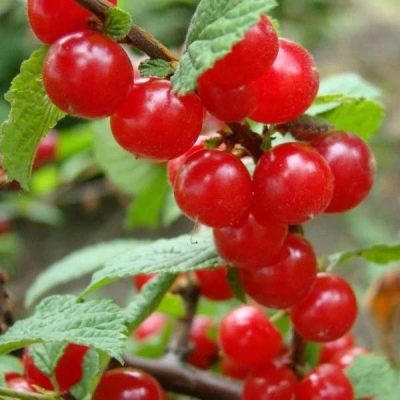
- Authors: Tsarenko V.P., Tsarenko N.A.
- Appeared when crossing: Summer x pollen mixture (seedling Pink + Red)
- Year of approval: 1999
- Barrel type: bush
- Growth type: medium-sized
- Crown: broadly oval dense
- Escapes: medium thickness, brownish brown, pubescent
- Leaves: small, dark green, wrinkled, with a double-toothed edge
- Flowers: saucer-shaped, medium size 2.5 cm in diameter of the corolla, five-lobed, white petals, free-standing
- Flowering and fruiting type: solid along the branch: on annual and perennial wood (bouquet twigs, fruit twigs)
Cherry Krasavitsa is an excellent felt variety that has a lot of advantages. High decorativeness, tasty fruits, frost resistance and disease resistance attract the attention of many gardeners. Let's consider the features of this type of culture in more detail.
Description of the variety
Medium-sized bushes reach a height of 1.6 m. Perennial straight branches are covered with a grayish bark prone to peeling. Annual shoots are brown and light fluff. Small dark green leaves are characterized by a wrinkled structure and double-toothed edges. Snow-white flowers grow singly or form inflorescences of 2 pieces. They have a beautiful saucer shape. Each flower consists of 5 petals and has a corolla diameter of 2.5 cm. The size of the pubescent peduncle is 0.4 cm. Flowering begins on May 20-27.
Fruit characteristics
The attractive berries are quite large. The average size of 1 piece is 15x16x15 mm, and the weight is 3-3.5 g. The shape of the fruit is round. There is a deep funnel at the base of each berry. The skin is covered with short, barely noticeable hairs. The color is dark pink. The pulp is red, dense, cartilaginous. The weight of the bone is 0.16 g. It is slightly more than half of the weight of the fruit and is not separated from the pulp.
Taste qualities
Sweet and sour berries are good fresh. And also delicious fruit drinks, compotes, preserves and jams are obtained from them. The gardeners' tasting score is 4 points out of 5. This is a very good indicator.
Ripening and fruiting
Berries appear in the 4th year after planting. In terms of ripening, the variety belongs to the late varieties. The fruits appear at the same time. This happens at the end of July.

Yield
The variety is considered to be high yielding. From one bush, you can get an average of 10 kg of juicy berries. However, it should be borne in mind that mechanized harvesting is not suitable for this variety. All fruits must be harvested by hand. And also it should be noted the weak transportability of berries.
Growing regions
Cherry Beauty is grown not only in the gardens of the middle lane, but also in the northern regions. The culture takes root well in the Urals, in the Central Black Earth Region, in the Vyatka, Volga, Far East and even in the western and eastern regions of Siberia.
Self-fertility and the need for pollinators
The variety is self-fertile. Other varieties of felt cherry can act as pollinators for it (2-3 varieties are enough).
Landing
The best time to plant seedlings is early spring. It is advisable to choose a well-lit area with loose soil. Saplings are placed at a distance of about 2 m from each other. The holes can be made shallow (0.5 m is quite enough).A combination of humus, dolomite flour, superphosphate and potassium sulfate is used as fertilizers. After placing the fertile composition in the hole, add water there to get a mushy mixture. Then seedlings are lowered into it. Before placing the plants in the holes, the roots are cut to 20 cm. This stimulates lateral branching. After the young bushes are immersed in the ground, the trunk circle is mulched with dry peat.


Growing and care
Every year after the end of flowering, the soil around the bushes is fertilized with organic matter, superphosphate and potassium nitrate. And also to maintain the optimal level of acidity, dolomite flour or wood ash is used. Loosening is done very carefully (not going deeper than 5 cm, so as not to hurt the root system). Watering should be moderate and sparse. The plant can withstand a slight drought, but waterlogging is destructive for it.
As for the formative pruning, it is necessary. Otherwise, the bush may grow too much, which will negatively affect the yield. Annual plants are cut to a height of 40 cm. When the crop reaches two years of age, a third of the length of all lateral shoots is removed. In the future, they eliminate small branches growing in depth, dried and diseased parts of the bushes, and also cut off the lateral shoots to the point of growth.


Disease and pest resistance
The variety is relatively resistant to clasterosporium disease, coccomycosis. However, with waterlogging, the culture can be affected by moniliosis. In this case, you should use the appropriate fungicides or biological preparations (for example, "Fitosporin-M"). The main thing is to be careful when trying the formulations on individual side branches to determine the optimal concentration. Standard grower recommendations may not be appropriate for delicate foliage crops.

Review overview
Gardeners enthusiastically talk about the lush bloom and luxurious greenery of Beauty's cherry. Culture adorns any area, and its bright berries delight with great taste.At the same time, the variety is unpretentious in care and rarely gets sick, which allows you to regularly get rich harvests.































































